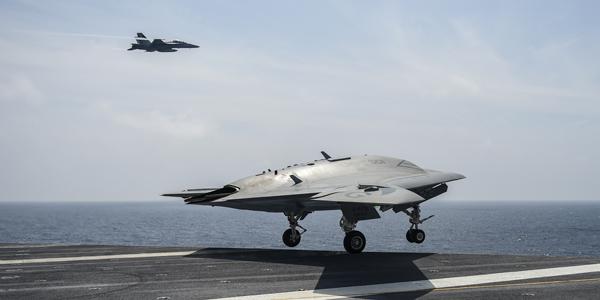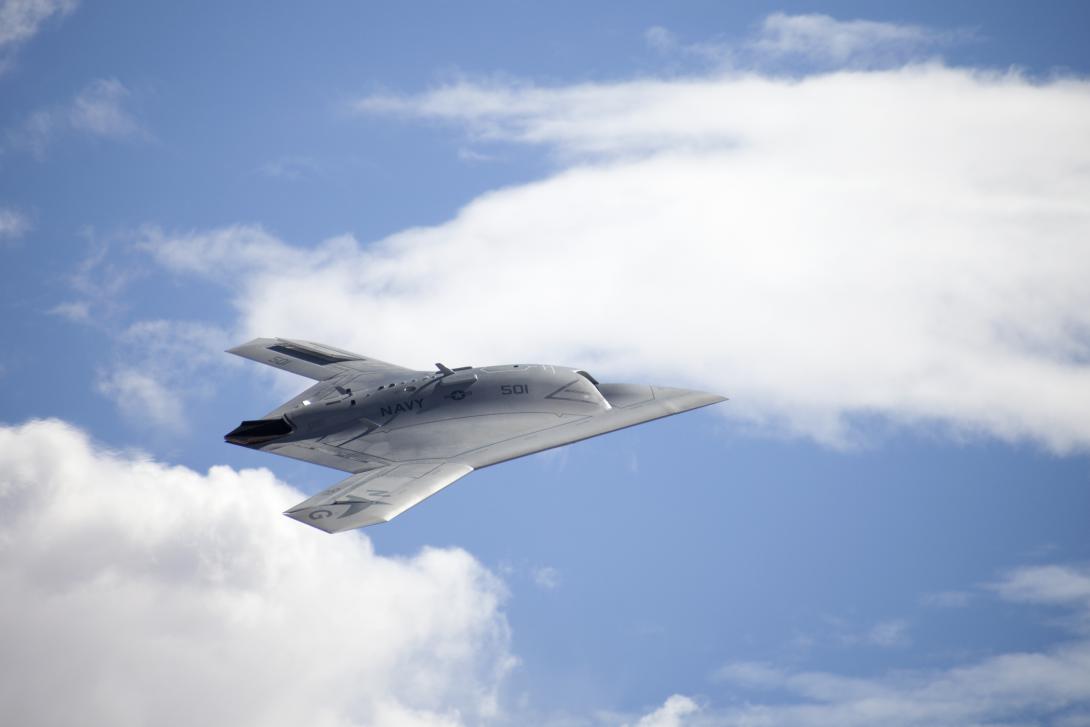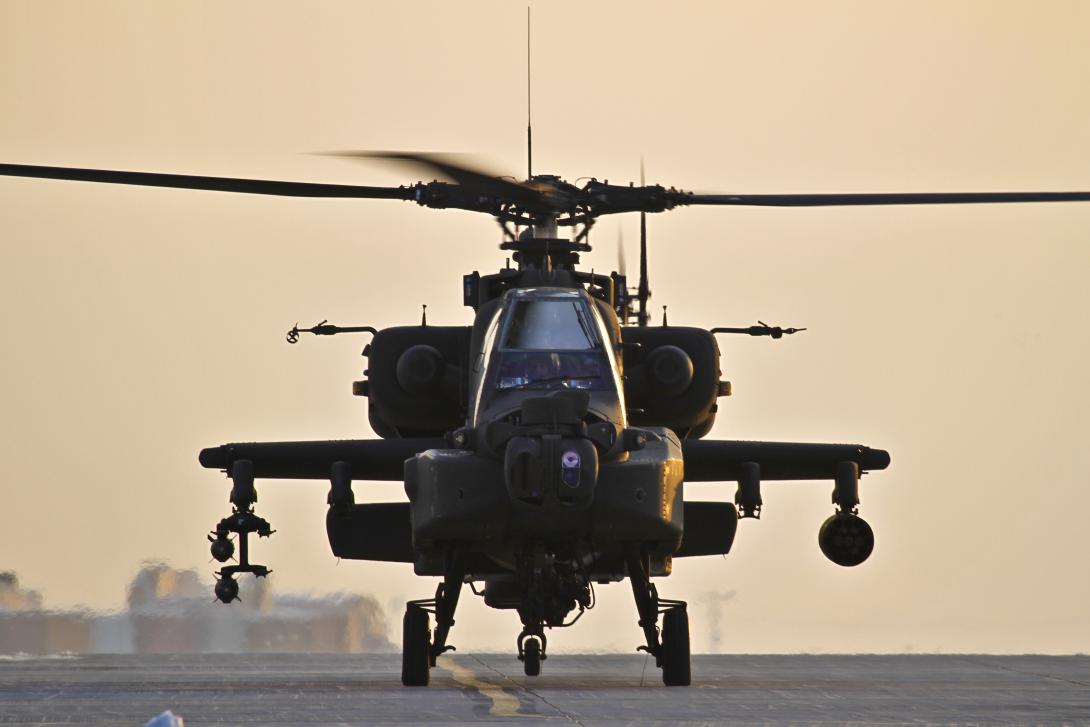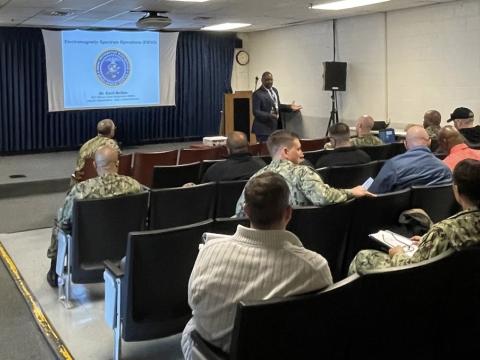Manned and Unmanned Systems Team Up for Warfighters
U.S. Navy officials have, for the first time, proved that the unmanned X-47B aircraft and an F/A-18 Hornet can operate at the same time within the same aircraft carrier-controlled landing pattern. Manned and unmanned aircraft flying from the same flight deck may change the way warfighters operate in the decades to come. They would improve carrier air wing proficiency by providing persistent intelligence, surveillance, reconnaissance, targeting and strike capabilities, offering warfighters greater flexibility and reducing danger to aircrews.
Manned and unmanned aircraft already work together in the same battlespace, but capabilities so far have been fairly rudimentary, says Capt. Beau Duarte, USN, program manager, Unmanned Carrier Aviation program office, Naval Air Systems Command, Patuxent River, Maryland. “On the battlefield, manned and unmanned teaming is already a reality in its early stages. Carrier-based manned aircraft operate over areas, such as Afghanistan, conducting national taskings in conjunction with land-based, strategic, unmanned air vehicles,” Capt. Duarte points out.
Developing unmanned systems capable of operating from the limited real estate aboard a carrier presents unique challenges, but the Navy took a step forward in what Capt. Duarte describes as a “truly historic” development. On August 17, the service conducted a series of flights from the USS Theodore Roosevelt using the X-47B, built by Northrop Grumman, and an F/A-18 Hornet. “The execution of this event will help refine the concept of operations for the integration of unmanned, carrier-based aircraft and will reduce the technical risk for future unmanned carrier aviation,” Capt. Duarte offers. “The flights are a glimpse into the future of the way the Navy will operate in the next decade with unmanned and manned aircraft side by side in the aircraft carrier environment.”
Integrating unmanned aircraft into carrier-based operations will provide warfighters multiple benefits, he adds. “Unmanned carrier-based air systems will improve the carrier air wing proficiency by providing persistent, responsive and affordable long-range reconnaissance, targeting and strike capabilities. Unmanned air systems also will provide flexible options for joint warfighters and have the ability to perform dangerous missions while reducing operational risks to aircrews,” he states. “The Navy is conducting studies right now to determine the optimal manned-unmanned mix aboard carriers within the air wing.”
The August flights marked the fifth set of at-sea test flights for X-47B as part of the Navy’s Unmanned Combat Air System Aircraft Carrier Demonstration (UCAS-D) program. “That effort encompasses the design, development and integration of the X-47B unmanned system into the aircraft carrier environment,” Capt. Duarte explains.
The lessons learned and technologies developed under the UCAS-D program also will benefit future platforms, such as the Unmanned Carrier-Launched Airborne Surveillance and Strike (UCLASS) system. UCLASS is described as the next evolutionary integration of unmanned systems into the carrier strike group operational environment. It will provide intelligence, surveillance, reconnaissance, targeting and strike capabilities. UCLASS, which the Navy hopes to field in 2020, has come under recent fire with critics calling the system redundant and already obsolete.
“The UCAS-D and the proposed UCLASS systems are two distinct systems as we enter into the future of naval aviation. The ongoing X-47 UCAS-D program is an essential early step that will demonstrate the potential suitability of an unmanned air system operating in the carrier environment,” the captain explains.
The UCAS-D program officials still have many lessons to learn. “We have only scratched the surface of manned-unmanned flight operations by demonstrating it is definitely feasible within an aircraft carrier environment to conduct manned and unmanned teaming. Many challenges remain, including conducting flight operations with different numbers and types of aircraft, day and night flights, as well as more challenging weather and flight deck motion conditions,” Capt. Duarte reveals. “The long-term goal is to make the integration of unmanned aircraft into the carrier air wing as seamless as possible.”
Navy officials do not yet know when the X-47B will return to sea for further testing. That date largely will be driven by carrier availability, which can be uncertain due in part to their participation in real-world operations. Still, the X-47B will not remain idle. “We’ve got some other potential uses for the X-47B that we’re investigating, including land-based testing and air refueling testing,” Capt. Duarte reveals.
For the August flights, the Navy developed and tested improvements to the X-47B arresting hook retract actuator, which automatically lifts the tailhook after landing so that it can clear the wire and the aircraft can taxi away from the landing area. Officials also loaded new software that will automatically fold the wings on command from a deck operator. The folding wings allow the X-47B to clear the landing area more expeditiously.
A deck-handling subsystem allows the X-47B to be taxied around the deck by an external operator. Other subsystems required for testing include networks, antennas, aircraft guidance and control and aircraft-mounted navigation systems that interface with an existing set of complex landing and display systems. No modifications are required for the F/A-18 Hornet.
“The X-47B met the program’s objectives to demonstrate that carrier-based manned and unmanned aircraft could maintain a 90-second launch and recovery interval. That was our threshold. Also, the overall vehicle air wing landing system performance in both nominal and off-nominal conditions—normal winds and winds of varying direction and intensity—is very accurate,” he reports.
The recent tests also included nighttime flight deck operations to “better understand the human interface and suitability of the unmanned air system and deck operator’s handheld control unit in a nighttime environment,” he adds.
Program officials prepared for the test for months using modeling and simulation, which the captain says were impressively close to the actual event. Still, the tests included some surprises. “In general, we have been very pleased with the level of precision and similarity that the vehicles displayed in regard to simulated or modeled performance that we expect. We were a little bit surprised with some of our nighttime flight deck taxiing, how hard it is to predict the speed at which the X-47B would accelerate or move on the flight deck,” Capt. Duarte reveals.
The Navy, of course, is not the only service teaming manned and unmanned aircraft. The Army, for example, is phasing out Kiowa Warrior helicopters and replacing them with AH-64E model Apaches, which can be teamed with unmanned aerial vehicles such as the Shadow and Gray Eagle. The unmanned vehicles can be operated either by soldiers on the ground or by the Apache pilots, and control can be passed from one to the other, depending on the need.
Meanwhile, Air Force Research Laboratory scientists recently completed an advanced communications affordability program aimed at improving production processes of Gallium Nitride Monolithic Microwave Integrated Circuits. Among other benefits, the technology is expected to boost communications for aircraft, which could positively affect manned-unmanned aircraft teaming efforts.
The various services and agencies work together as much as possible to improve manned-unmanned teaming technologies and capabilities, Capt. Duarte reports. “Sharing lessons learned is extremely important. It drives not only a more technical solution but also a more affordable solution. We continue to leverage findings from other Navy unmanned acquisition programs such as Triton and Fire Scout, as well as our sister services, and from joint concepts of operations,” Capt. Duarte says.
“UCLASS will be the first carrier-based, operational unmanned system integrated into the air wing, and in my view, it will not be the last. We look forward to turning the potential into reality in the coming years,” he concludes.







Comments